2020 Yamaha EX Review
How does Yamaha’s budget PWC compare to the Sea-Doo SPARK?
Engine: Three cylinder 1,049cc
Fuel Capacity: 13.2 gal.
Stowage Capacity: 7.7 gal.
Seating Capacity: 3
MSRP: Starting at $6,899
Yamaha waded into the Rec-Lite category in 2017, unveiling an EX line that used an entirely new hull and deck platform, borrowed from the VX in terms of power, and never let go of the company’s trademark standards. The most affordable of the trio, the simply titled 2020 Yamaha EX, may not have come down to the Sea-Doo SPARK’s entry-level pricing, but when compared apples-to-apples with similar horsepower and passenger capacity, set up an intriguing showdown between the two manufacturers.
Yamaha DNA
Though the 2020 Yamaha EX lowers the price of entry into the WaveRunner family as low as $6,899, the craft is still classic Yamaha. For one, that means the hull remains SMC, or Sheet Molding Compound, the familiar, fiberglass-based material at the heart of off all WaveRunners. Physical size also remains larger than Rec Lite competition. At 10’ 3”, the EX is 9” shorter than the midrange VX (a craft that the EX hull is based on), but still retains Yamaha’s trademark stability. Those physical dimensions also make the EX roomy enough for three. No, you won’t want to do it on a regular basis, but three adults are possible with the craft’s 485-pound weight capacity. A more comfortable trio would be two adults and a child. The craft’s physical size and stability also makes the EX able to handle rougher, larger waters on occasion.
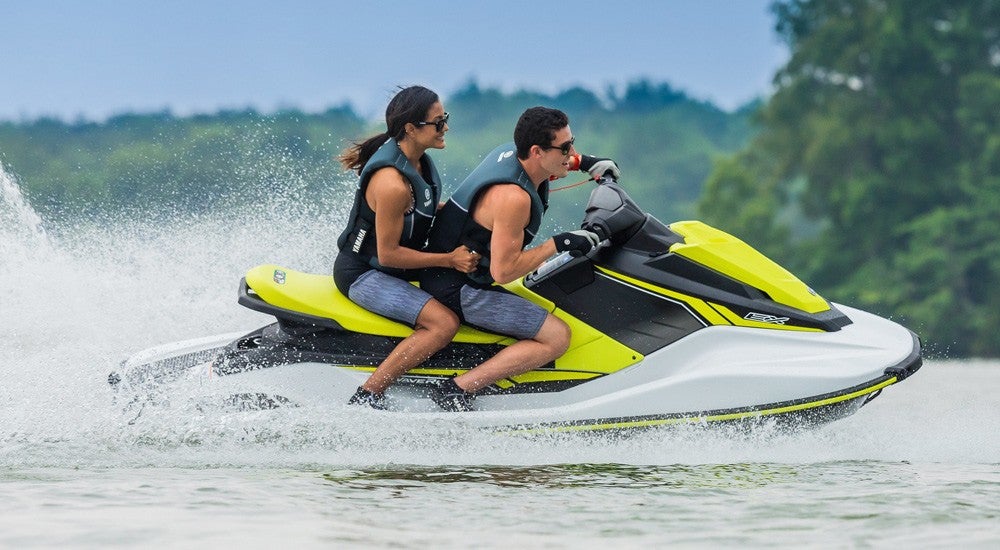
Visually the craft also remains classic Yamaha, though styling has been streamlined. Colors and graphics also follow familiar, though simplified Yamaha cues. The hull is black, the deck mostly white, and front storage, seat base and saddle a base of black with bright, fluorescent yellow accents. The saddle is slimmed to fit the overall proportions. Remove it to perform basic tasks like checking the oil level or maintaining the battery. More extensive engine access is accomplished by removing a composite seat base; it can be unbolted from the deck. Deck mats are standard, and actually offered in a two-tone pattern for additional style.
As to the engine of the 2020 Yamaha EX, it’s familiar, the 1,049cc TR-1. In the EX it’s slightly detuned to an even 100 horsepower. That results in a top speed of about 50 mph and acceleration similar to the midrange VX. Fuel capacity lists at 13.2 gallons, which greatly extends the craft’s range in comparison to Rec Lite competition. There’s also 7.7 gallons of standard, not optional, storage, split between a shallow front tub and glovebox.
Hands On
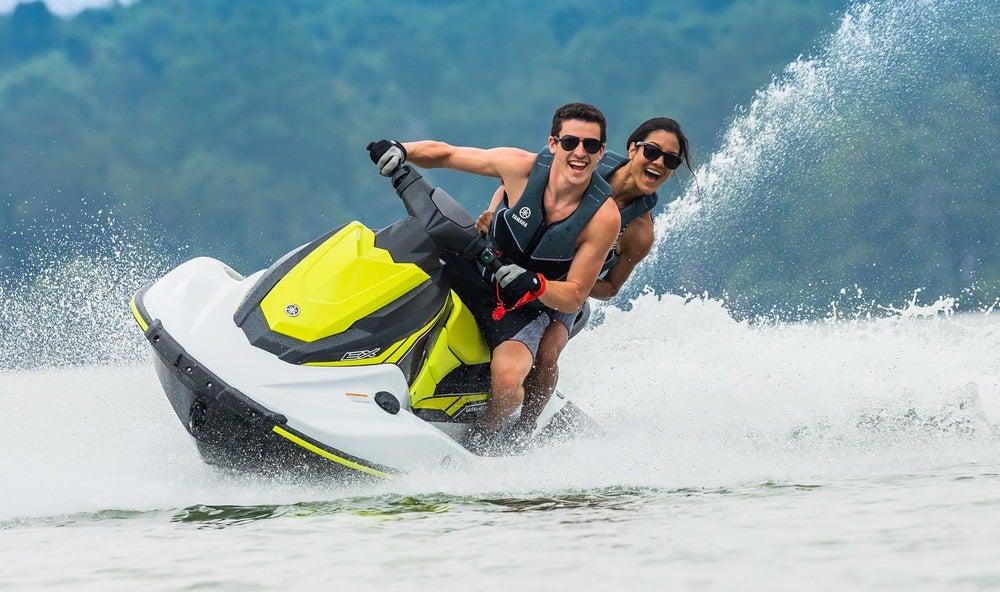
As to the ride, like Sea-Doo’s SPARK the EX is more playful than its larger, pricier siblings. You can still carve a turn with precision but get your weight off the stern and flick the bars and you can spin out into a 180. The EX retains a more locked-in feel than the SPARK, however, which is a plus or minus depending on the kind of ride you’re searching for. That more precise feel is appreciated in lousier conditions, as are the extra inches in physical size.
One thing missing on the 2020 Yamaha EX, like the base model SPARK, is reverse. It’s a tradeoff for the price point, but a tradeoff worth considering. No reverse means you’ll have a more difficult time docking, maneuvering in tight quarters, getting off the trailer, etc. The EX Sport adds $1,000 to the price tag, but does include mechanical reverse, rearview mirrors, and a reboarding step.
Yamaha introduced a few notable accessories for 2020 that fine-tune the user experience. EcoXGear Bluetooth speakers ($349) can be added to the cowl to deliver tunes from your phone or similar Bluetooth music source. The shallow bow tray can also be changed out for a 20.5-liter roll-top, dry storage bag ($75.99). Finally, a small, waterproof, compression molded storage caddy ($54.99) with clear front panel can be added where a display would normally go on a larger machine to house a smartphone.
How ‘Bout Them Apples?
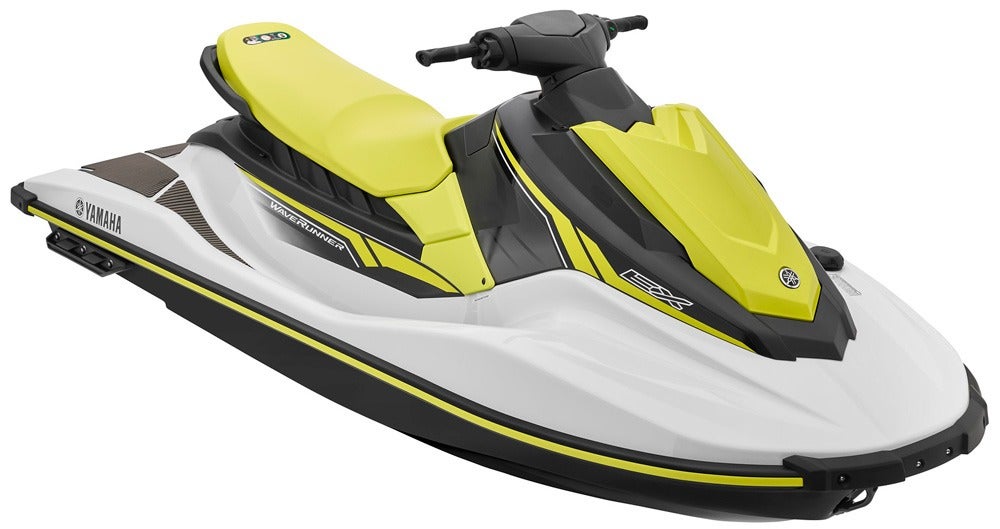
So back to that apples-to-apples comparison. The Sea-Doo SPARK in three-passenger configuration, with 90hp engine and optional front storage bin totals $6,863.99, essential an identical price to the 2020 Yamaha EX. In this scenario, the Yamaha is just over three inches longer, the SPARK two inches wider; the EX has a 35-pound advantage in rider capacity; the EX offers 10 more horsepower; and the EX is about 150 pounds heavier. Yamaha holds a notable advantage in fuel capacity (13.2 gallons versus 7.9) and, I’d argue, a superior ride in rougher conditions. The SPARK is lighter and more playful.
As to construction, I think it’s a moot point. SMC may be more rigid, but also more prone to splintering and cracking from gentler impacts. Ordinary, careful use shouldn’t really expose a weakness with either.
Ultimately, it’s not really a case of one craft being better, but rather which one is better for how you see yourself using it. Either way you’ll have a craft that’s easy to tow and stow, easy on the wallet when it comes to initial purchase and fuel costs…and fun to ride.
Get PersonalWatercraft.com in your Inbox!
Like PersonalWatercraft.com on Facebook
Related Stories
Comments
Most Popular

2025 Yamaha JetBlaster PRO 2-Up Review

Remembering the Sea-Doo XP

2024 Kawasaki Jet Ski STX 160X Review

Whatever Happened to the Wetbike?

2025 Yamaha JetBlaster Review




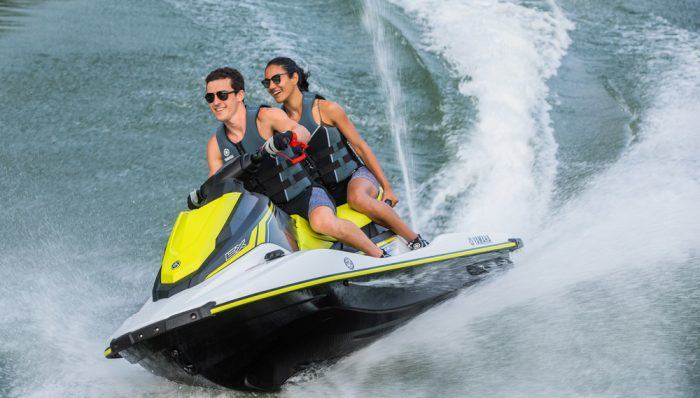


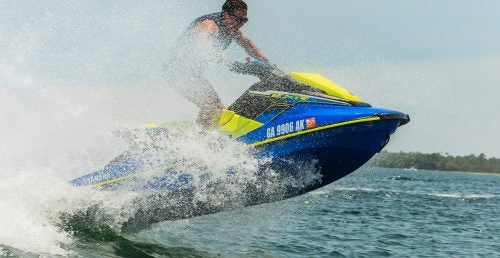






 Your Privacy Choices
Your Privacy Choices